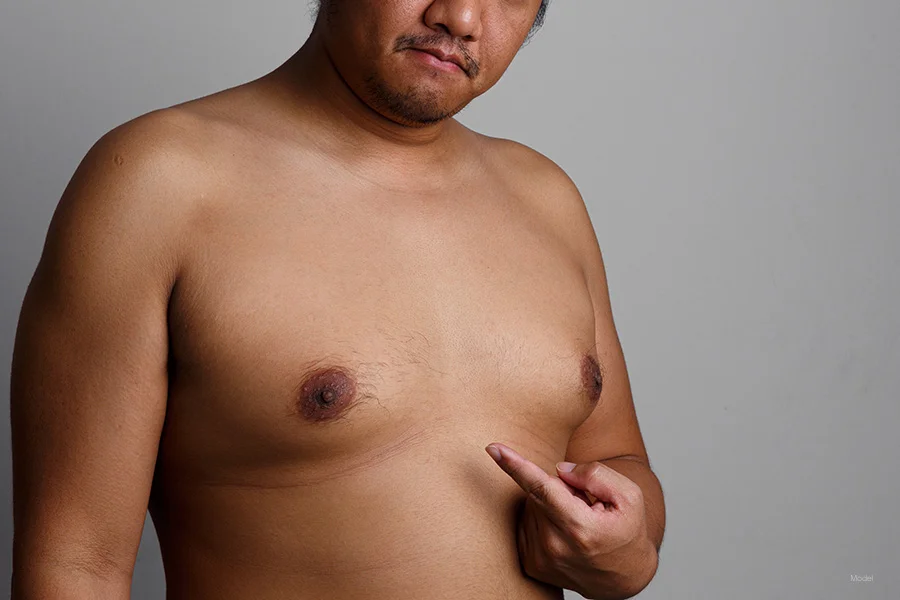Home|Blog | Can I Fix My Gynecomastia on My Own?
Can I Fix My Gynecomastia on My Own?
For many men, gynecomastia can be a source of physical and emotional discomfort. Fortunately, there are various approaches to address this condition, ranging from medication and lifestyle modifications to surgical interventions like liposuction and male breast reduction surgery. While true gynecomastia cannot usually be corrected with self-help measures, pseudogynecomastia often can.

In this guide, we’ll explore the difference between gynecomastia and pseudogynecomastia and diverse strategies for correcting these conditions, including diet, exercise, medication, liposuction, and male breast reduction surgery.
What Is Gynecomastia?
Before delving into correction methods, it’s essential to understand what gynecomastia is and its potential causes. Gynecomastia, or enlarged male breasts, is caused by glandular proliferation (enlarged breast tissue) and can result from hormonal imbalances, anabolic steroids, certain medications, marijuana or underlying health conditions.
It is characterized by the enlargement of male breast tissue, often causing embarrassment, psychological distress and decreased self-confidence.
What Is Pseudogynecomastia?
Some men with enlarged breasts have true gynecomastia, but others have what is called pseudogynecomastia. It often appears identical to gynecomastia but the underlying cause is increased fat deposition; that is, the enlargement of the breasts is the result of fat. This is commonly seen in men who are overweight.
Very frequently, the enlargement of breasts in males is due to a combination of both increased glandular tissue as well as of fat.
Gynecomastia and pseudogynecomastia.
This is important as the surgical and non-surgical options are different depending on the cause of the male breast enlargement.
Non-surgical Treatment for Enlarged Male Breasts
When at least some of the breast enlargement is due to fat, then weight loss may help to reduce the breast size. In some situations, it may even completely resolve without the need for surgery. This is particularly applicable to those men who are overweight.
The best way that weight loss can be accomplished is by a combination of dietary modifications and increased exercise.
Reducing caloric intake and burning off more calories.
When there is only glandular tissue present, this approach rarely will have an effect. However, weight training involving the chest can ultimately yield a more sculpted appearance.
Lifestyle Changes for Gynecomastia and Pseudogynecomastia
Smoking (and vaping) marijuana has been long known to lead to gynecomastia in some men. Refraining from using marijuana will not reverse gynecomastia once it has developed but it can remove that particular risk of making it worse.
Men who take anabolic steroids, such as those used in bodybuilding, are at higher risk for developing gynecomastia. In fact, it can even develop after only one cycle. Stopping anabolic steroid usage likely won’t resolve the gynecomastia but it will minimize the risk of additional glandular tissue growth.
Pursuing a healthier lifestyle involving diet, exercising and getting down to a “normal” weight can help both reduce pseudogynecomastia and decrease the risk of it becoming worse.
Medications That Can Target the Causes of Gynecomastia
In situations where hormonal imbalances are contributing to the development and worsening of gynecomastia, hormone therapy may be prescribed. This approach aims to restore a balance between estrogen and testosterone levels.
Another course of action that can be effective is the usage of selective estrogen receptor modulators (SERMs) like tamoxifen and raloxifene. By blocking the estrogen receptors, these medications can reduce breast tissue growth.
Liposuction for Enlarged Male Breasts
When at least part of the breast enlargement is caused by excess fat, liposuction can be a very effective treatment. This approach uses around two very small incisions (approximately 1/4 to 3/8 inch in length), strategically placed, through which suctioning of the fat can be done using metal tubes called cannulas. The incisions usually heal very well and are relatively inconspicuous.
Unfortunately, glandular tissue, as seen in true gynecomastia, can’t be removed with liposuction. Therefore, those men who also have glandular tissue contributing to their enlarged breasts will need the direct removal of this tissue as well.
Gynecomastia Surgery (Male Breast Reduction)
The treatment of gynecomastia is by the direct excision of the breast tissue, typically through an incision placed along the lower half of the areolar margin. In cases of pseudogynecomastia where there is also glandular tissue present, this is done in addition to the liposuction in order to completely address the enlargement.
When there is excess, lax skin associated with gynecomastia, skin excision with breast contouring will also need to be performed in order to obtain a desirable result.
Aftercare and Recovery
When undergoing treatment of gynecomastia or pseudogynecomastia, proper aftercare and recovery are essential for achieving optimal results. Following postoperative instructions, attending follow-up appointments and adopting a healthy lifestyle to maintain the improvements achieved through intervention are crucial for a satisfying and long-lasting outcome.
Choosing the Right Approach
The most suitable approach for the treatment of your gynecomastia (or pseudogynecomastia) depends on the tissues causing your breast enlargement. This can best be determined by seeing a consultation with a reputable and experienced plastic surgeon who is board certified by the American Board of Plastic Surgery.
Treatment for Your Gynecomastia
Dr. Steven H. Turkeltaub, a plastic surgeon in the Scottsdale and Phoenix area, is board certified by the American Board of Plastic Surgery. He is extensively experienced in the treatment of gynecomastia and has done so in the Scottsdale and Phoenix areas for more than 35 years. He has also been selected as one of “America’s Top Plastic Surgeons.”
If you would like to learn more about the treatment of gynecomastia or to schedule your complimentary consultation with Dr. Turkeltaub, please contact our office either by calling (480) 451-3000 or by email.
